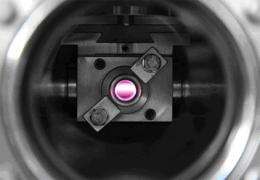The 'natural' asymmetry of biological molecules may have come from space

Certain molecules do exist in two forms which are symmetrical mirror images of each other: they are known as chiral molecules. On Earth, the chiral molecules of life, especially amino acids and sugars, exist in only one form, either left-handed or right-handed. Why is it that life has initially chosen one form over the other?
A consortium bringing together several French teams led by Louis d'Hendecourt, CNRS senior researcher at the Institut d'astrophysique spatiale, has for the first time obtained an excess of left-handed molecules (and then an excess of right-handed ones) under conditions that reproduce those found in interstellar space. This result therefore supports the hypothesis that the asymmetry of biological molecules on Earth has a cosmic origin. The researchers also suggest that the solar nebula formed in a region of massive stars. This work has just been published on-line on the web site of The Astrophysical Journal Letters. The experiment was carried out at the SOLEIL synchrotron facility.
Chiral molecules are molecules that can exist in two forms (enantiomers) which are symmetrical mirror images of each other, one left-handed and the other right-handed. For instance, our hands are chiral since they come in two forms, the left hand and the right hand, that are symmetrical with their mirror image but not super imposable on it. Biological molecules are mostly chiral, with some forms being favored over others. For instance, the amino acids that make up proteins only exist in one of their two enantiomeric forms, the left-handed (L) form. On the other hand, the sugars present in the DNA of living organisms are solely right-handed (D). This property that organic molecules have of existing in living organisms in only one of their two structural forms is called homochirality.
What is the origin of such asymmetry in biological material? There are two competing hypotheses. One postulates that life originated from a mixture containing 50% of one enantiomer and 50% of the other (known as a racemic mixture), and that homochirality progressively emerged during the course of evolution. The other hypothesis suggests that asymmetry leading to homochirality preceded the appearance of life and was of cosmic origin. This is supported by the detection of L excesses in certain amino acids extracted from primitive meteorites. According to this scenario, these amino acids were synthesized non-racemically in interstellar space and delivered to Earth by cometary grains and meteorites. To lend more weight to this hypothesis, the researchers first reproduced analogs of interstellar and cometary ices in the laboratory. The novel aspect of their experiment was that, using the DESIRS beamline at the SOLEIL synchrotron facility, the ices were subjected to circularly polarized ultraviolet radiation (UV-CPL), which is supposed to mimic the conditions encountered in some space environments. When the ices were warmed up, an organic residue was produced. A detailed analysis of this mixture revealed that it contained a significant enantiomeric excess in one chiral amino acid, alanine. The excess, which was over 1.3%, is comparable to that measured in primitive meteorites. The researchers thus succeeded in producing, under interstellar conditions, asymmetrical molecules of life from a mixture that did not contain chiral substances. This is the first time that a scenario that explains the origin of this asymmetry has been demonstrated using an experiment that reproduces an entirely natural synthesis.
This result reinforces the hypothesis that the origin of homochirality is prebiotic and cosmic, in other words genuinely interstellar. According to this scenario, the delivery of extraterrestrial organic material containing an enantiomeric excess synthesized by an asymmetrical astrophysical process (in this case, UV-CPL radiation) is the cause of the asymmetry of life's molecules on Earth. This material may even have formed outside the solar system. Finally, the solar nebula may have formed in regions of massive star formation. In such regions, infrared radiation circularly polarized in the same direction has been observed. These findings imply that the selection of a single enantiomer for the molecules of life observed on Earth is not the result of chance but rather of a deterministic physical mechanism.
More information: Non-racemic amino acid production by ultraviolet irradiation of achiral interstellar ice analogs with circularly polarized light. Pierre de Marcellus, et al. The Astrophysical Journal Letters, vol. 727 (issue 2), L27 (2011). iopscience.iop.org/2041-8205/727/2/L27
Provided by CNRS





















